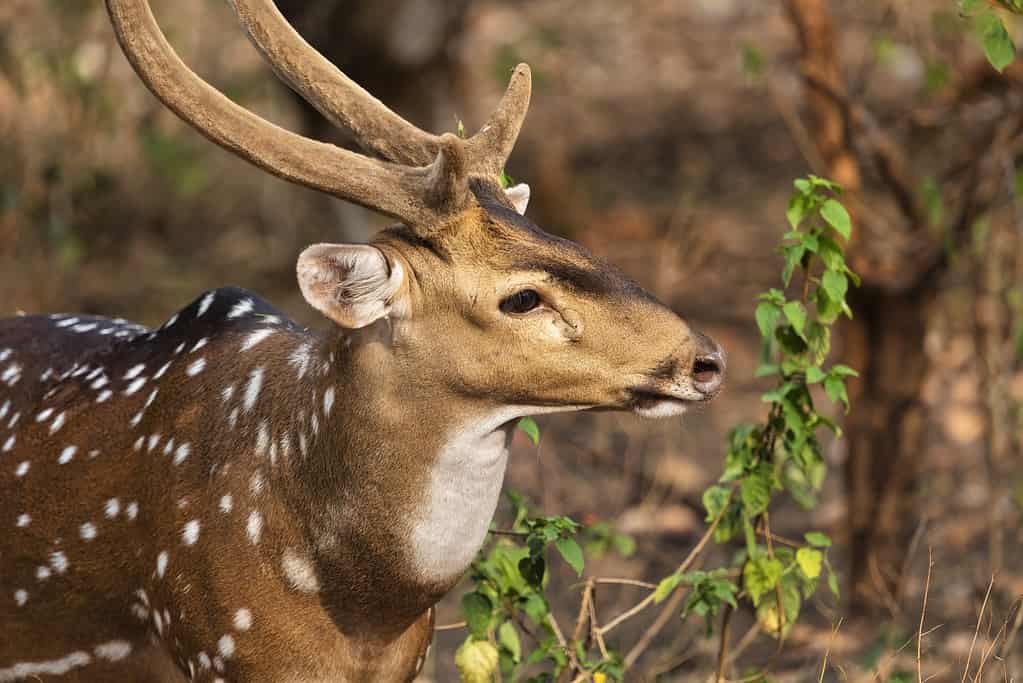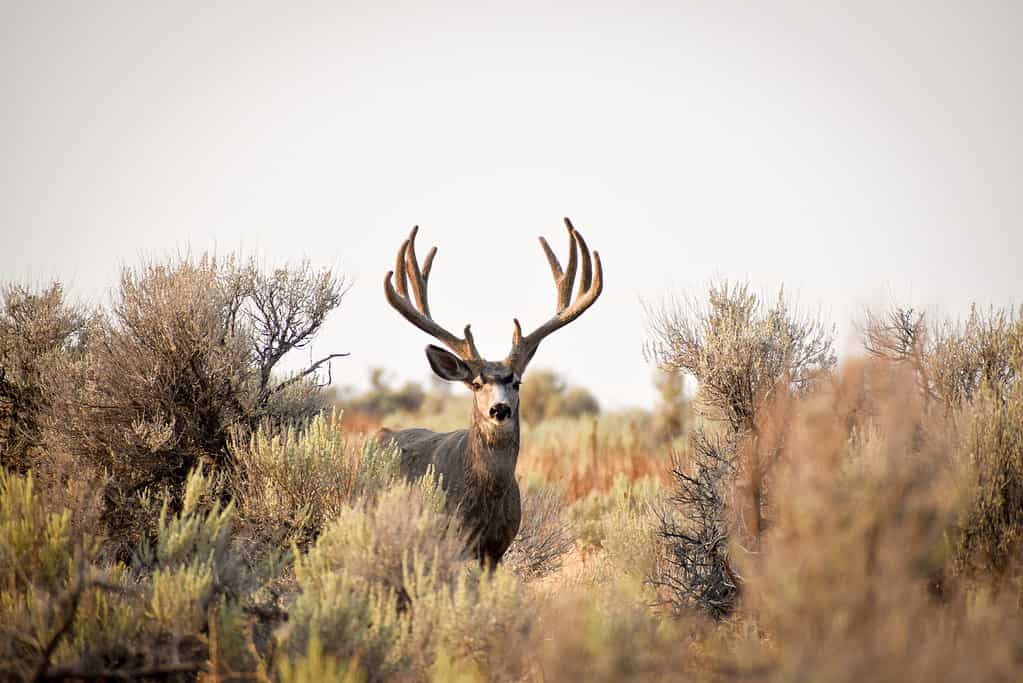Even if you aren’t a hunter, there’s something quite impressive about coming across a deer with huge antlers. But they might lead you to wonder why some deer have large antlers, and why some are small.
While it’s not an easy answer, some factors play a large role in determining deer antler sizes. If you want to learn more about antlers and how they grow, you’ll need to keep reading below.
How Large Do Deer Antlers Get?

Different species of deer will have different average
antler
sizes and different growth rates.
©Roop_Dey/ via Getty Images
Mule deer have antlers larger than 42 inches wide and 40 inches tall. On average, a whitetail and mule deer’s antlers grow a quarter inch a day. With the growing season lasting for roughly 120 days, 30 inches or so is the average.
If you want to understand how much 30 inches of antlers really are, it’s estimated that in those 120 days, a deer grows over 200 inches of bone on the top of their head. These antlers weigh anywhere between three and nine pounds.
However, some unique individuals have even larger antlers. It’s not always easy to determine exactly how large the antlers are, as antlers are usually measured by points rather than inches when found. For example, the biggest recorded deer antlers were almost 334 points.
What Do Different Antler Sizes Mean?

Velvet on a deer’s antlers may lead them to look bigger than they actually are.
©Chad J Stokes/iStock via Getty Images
The size of deer antlers doesn’t necessarily have anything to do with the deer themselves. They aren’t specifically a sign of dominance. As deer age, they produce bigger and bigger antlers until they hit a peak growth.
Deer antlers tend to peak at about five to seven years of age. So to put it simply, different antler sizes generally represent different ages. However, that’s not the only reason that deer may have large antlers.
Enough factors can change the growth rate of antlers and just looking at the size doesn’t provide accurate information on the age of the animal. This is why teeth are often used to determine age, rather than antler size.
If a deer has abnormally large antlers, it’s usually a sign that they hit the jackpot. Not only did they live to a good age, but they had great genetics and even a good date of birth.
What Factors Contribute to Antler Sizes?

Unlike
caribou
, only male deer have antlers.
©SwedishStockPhotos/Shutterstock.com
There are a few known factors that influence antler sizes, but it’s suspected that there are more minor factors in play as well.
Nutrition
Growing antlers, and quickly at that, requires a lot of energy. While deer antlers don’t grow as fast as some other species like elk and moose, they still require a lot of energy.
To fulfill their energy needs, deer need a lot of nutrition. A skinnier deer that doesn’t get a lot of food usually ends up with smaller or more feeble antlers than others.
Protein plays a big factor in deer antlers. A steadier and higher amount of protein in a buck’s diet leads them to have racks that are 20 or points higher on average than deer that have less or more inconsistent levels of protein.
It’s thought that the reason female deer tend to live longer than male deer is because of the energy it takes to make the antlers. Spending so much energy year after year to produce antlers wears out the body over time, and leads to an earlier death.
Age
Age, of course, plays a huge role in the size of antlers. The reason why many deer don’t have exceptionally large antlers is because they rarely make it to peak age.
For whitetail deer, they reach their peak antlers between four and six years of age. Some other deer are between six and eight.
However, as predators and humans hunt and kill deer before they reach this peak, they don’t get the chance to grow their racks to their full size before they’re killed.
Human Selection
Since people tend to focus their attention on deer with bigger racks during hunting season, hunters are selectively breeding deer to have smaller and smaller antlers.
How so? Well, deer with big antlers don’t always have the time to reproduce before they’re hunted. This means that deer with smaller antlers are doing more work repopulating the herd than deer with large antlers. Over time, there are fewer and fewer deer with large antlers, and they become somewhat of a rarity.
This is being offset a little through a technique called culling. When deer populations are higher than normal hunting can handle, wildlife departments will do an additional culling. During these specialized hunts, the department focuses on inferior animals, rather than the ideal ones.
This serves two purposes. For one, it helps to balance the genetics of the herd. Second, it helps provide more nutrients for the more ideal specimens. Even if there’s not enough culling done to change the genetics of a herd, culling a population provides more food resources to the remaining deer.
Genetics
Genetics also plays a role. It’s been proven that deer with large antlers have offspring with large antlers as well.
However, genetics usually falls behind other factors. It doesn’t matter if a buck’s father had big antlers if they are young and starving.
Amongst deer with similar environmental conditions and of a similar age, the bucks with a family history of bigger antlers will generally have the biggest racks in the group.
Injuries
Because antlers are made from calcium, injuries to other bones have the potential to stunt antler growth. For example, one of the most common injuries to deer, leg injuries from car accidents, tends to lead to deformed and smaller growth of antlers.
Interestingly, it’s usually the antler on the same side of the body as the leg injury that is deformed. For example, if a deer hurts its back right leg, the right antler will look strange or grow smaller. It may be smaller, or in a weird shape. If a leg injury is severe enough, it may even stunt the antler growth for several years. Most of the time, the left side will be rather normal in appearance.
Other reasons for deformed antlers often have to do with the antlers themselves. For example, if there’s damage to the area where the antlers grow from, known as the pedicle, the antlers will have difficulty growing or may grow in strange shapes.
Injuries to the pedicle are rather common. As deer grow older and fight, they are likely to injure one another in the area. These injuries may lead to malformed antlers for the rest of the deer’s life.
Velvet injuries also play a role in deformed antlers. However, these deformations usually only last for the season. The next set of antlers will be fine at the start of the next season unless another velvet injury occurs.
Velvet is the antler before it’s hardened into bone. They are softer and more sensitive at this point, and much more likely to be damaged than a hardened antler would be.
There’s Still Not Enough Known

Deer antlers are extensions of their skulls shed and regrown each year.
©iStock.com/Kerry Hargrove
While these are the main factors, studying deer and their antler growth has shown that these aren’t the only factors that play a part. There is enough variation in antler growth that scientists are sure that other factors have to be in place.
Some of the other factors theorized to play a role include soil quality, stress levels, health, and habitat health.
Thank you for reading! Have some feedback for us? Contact the AZ Animals editorial team.








